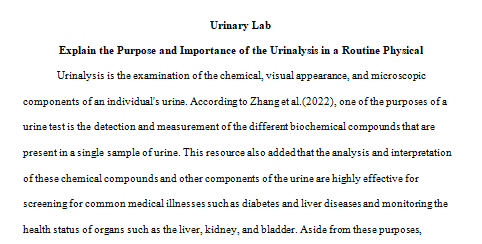In this lab you will analyze results of the patients urinalysis from a routine physical.
In this lab you will analyze results of the patients urinalysis from a routine physical.
Assessment 3 Instructions: Homework: Urinary Lab
- In this lab you will analyze results of the patients urinalysis from a routine physical.
FLUID REGULATION IN THE BODY
To understand body regulation, we will examine the endocrine, lymphatic, and urinary systems—and the roles that they play.The glands of the endocrine system regulate hormones throughout the body. The endocrine system contains trillions of cells that operate in coordination with one another. It is a collection of glands that produce hormones that regulate many body functions such as growth, metabolism, tissue function, sexual function, sleep, and mood.The lymphatic system helps regulate unwanted chemicals and toxins in the body through a system of tissues and organs. Without the lymphatic system, we would not be able to fight off disease. It drains fluid (called lymph) that has leaked from the blood vessels into the tissues and empties it back into the bloodstream via the lymph nodes.The urinary system also gets rid of waste from the blood. The kidneys make urine by filtering wastes and extra water from the blood. Urine travels from the kidneys through two thin tubes called ureters in order to fill the bladder. Our body depends on this system to regulate the fluid balance within our body.
OVERVIEW
This assignment is about the urinary system. The assessment addresses the way the kidney couples waste removal with homeostatic mechanisms for regulating blood volume, blood pressure, and the balance of ions in the blood.Kidneys have a tremendous capacity for processing fluid, so much so that we can live quite well with only one kidney. However, the loss of both kidneys requires intervention by dialysis to replace the waste removal capability, and hormone replacement to maintain other aspects of homeostasis.The high-capacity filtration capability of the kidneys results from millions of nephrons, the basic functional unit of the kidney. The nephron plays a role in the three physiological processes of filtration, reabsorption, and secretion.This lab will illustrate the purpose and importance of the urinalysis in a routine physical. In the following lab, you will review the lab results of Tanya’s friends Marcus and Darlene. Review their labs to see what information is provided in their urine. Be ready to explain why each patient’s condition would explain their lab results in the lab scenario, especially what diabetes is and the difference between type 1 and type 2 diabetes.
INSTRUCTIONS
Remember the following as you go through the lab:
- Complete the assessment at the end of the lab. To do this, fill out the items requested within the lab, download that document or documents to your computer, and save it. You must attach the documents to the assignment and then submit the assignment.
- Make sure that you read the Homework: Urinary System Lab Scoring Guide prior to submitting your document to ensure you have met all of the expectations for this assignment.
- It is recommended to review the scoring guide prior to downloading your document, or documents, to your computer, since all work must be completed within the lab.
COMPETENCIES MEASURED
By successfully completing this assignment, you will demonstrate your proficiency in the following course competencies and assessment criteria:
- Competency 1: Describe the organization of the human body.
- Explain the purpose and importance of the urinalysis in a routine physical.
- Explain what diabetes is and the difference between type 1 and type 2 diabetes.
- Explain why blood may be in the urine.
- Explain the condition that would explain a patient’s results in a lab scenario.
- Document urinalysis results appropriately.
Requirements: | .doc file
Answer preview for the paper on ‘In this lab you will analyze results of the patients urinalysis from a routine physical.’

APA 1025 words
Click the purchase button below to download full answer…….
